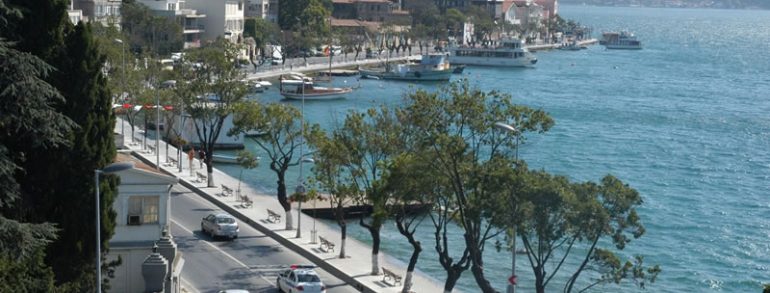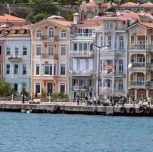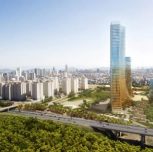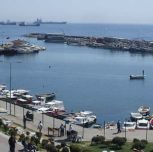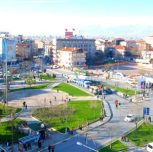Sarıyer is the northernmost district of Istanbul, Turkey, on the European side of the city. With a long shore along the water, the district boasts both a beautiful coastline and a lush forest. The Sarıyer district is a huge area consisting of the villages on the European side of the Bosphorus from Rumelifeneri, down through Tarabya, Yeniköy, İstinye, Emirgan to Rumelihisarı. Sarıyer also administers the Black Sea coast to the west of the mouth of the Bosphorus including the village of Kilyos. Its neighbours are Eyüp the northwest, Beşiktaş the south and Kağıthane the west. Sarıyer has a population of approximately 260,000. Some parts of Beyoğlu and Çatalca was joined and Sarıyer became district centre in 1930. District boundaries were shrunk after county of Kemerburgaz was given to Eyüp in 1936 and villages of Maslak and Ayazağa were given to Şişli in 1954. Sarıyer has present boundaries after joining boroughs of Maslak, Ayazağa and Huzur from Şişli district in 2012.
The North Bosphorus
Sarıyer's Bosphorus villages, backed by steep hills, were once rural fishing communities. They later became retreats for the city's wealthy. In the Ottoman period the sultans came to these villages for picnics and excursions. During the 18th and 19th centuries, the coast was lined with summer residences of the wealthy foreign traders of Pera and Galata. Many foreign embassies built summer residences in this period. Since the construction of the coast road, these villages, and increasingly the hillsides behind them, house many expensive villas owned by İstanbul's rich businessmen, actors and musicians, attracted by the coastline and the lush forest behind.
Sarıyer has recently been supplied with natural gas. Significant parts of the district have also seen the installation of a new drainage system, particularly in the village of Sarıyer itself and along the coast road. These projects have led to chronic road construction and its attendant traffic. Sarıyer itself has particularly heavy traffic.
The coast road running through Sarıyer is lined with fish restaurants of all kinds, ranging from the most elegant to equally delicious small restaurants, many of which were formerly housed in boats moored by the sea wall. Unfortunately this coast is so popular with day-trippers and Sunday drivers that at weekends the pleasure of a drive along Sarıyer's is mitigated by the crawling queues of traffic.
In addition to the coast road, Sarıyer is connected to the downtown historic and financial centers by Buyukdere Road, the main road from Beşiktaş up to Maslak and beyond; this is the route used by minibuses serving Sarıyer-Beşiktaş. There is also high-speed ferry boat service for commuting to the city. However, as a drive through Sarıyer during commute times and rush hour will attest, many people commute by car.
The Bosphorus communities of Sarıyer include (south to north):
Emirgan is former retreat from the city, backed by a hillside still green despite the recent construction of villas within it. The district is named for the Ottoman lords (Emirs) that came here on excursions. There is a lovely square in the center, shaded by a huge plane tree, with a cafe in the middle. Home to the Sakıp Sabancı Museum.
Reşitpaşa is a crowded district on the hill above Emirgan. It is a big village, with attractive villas and lots of illegal gecekondu housing on a forested hillside. The modern campus of the Istanbul Stock Exchange is nearby, as are one campus of the Istanbul Technical University and a large new mall, Istinye Park.
Istinye is a fishing port, which once contained a shipyard, with a village behind and tea gardens by the sea. As in so many other areas, luxury condos now rise from Istinye's hillsides. In 2003 the imposing American consulate was built here. The town's stream was once polluted with sewage. The stream is now biologically treated to eradicate any effluent to the Bosphorus.
Yeniköy consists of luxury villas on a hillside and a small area of tightly packed old houses near the sea. The latter area, the old village, has a longstanding Greek community, evidenced by its Orthodox churches. Yeniköy's long-established cafes and bakeries lends to a cosmopolitan feeling reminiscent of old Istanbul. Former prime minister Tansu Çiller lives in a town-house on the seafront. In recent years Yeniköy has acquired a community of Filipinos, working as domestic help in the big villas.
Tarabya was formerly the Greek Theràpia, the name of which comes from the Greek word therapeia (therapy) and indicates the area's former use as a sanctuary from the city for the sick. It is now a classy neighbourhood, dominated by the once grand Tarabya Hotel. There are fish restaurants and 'taverna' featuring traditional Turkish music, drink, and atmosphhere. Marmara University has a small site here, teaching French, housed in a villa built by Alexander Ypsilantis. A stream once flowed to the Bosphorus, but is now covered by concrete. Tarabya also is home to the German consulate.
Büyükdere was formerly the Greek-Byzantine Vathys Kòlpos District, 'the deep gulf' in Greek). It was originally a quiet residential area composed mostly of old, quiet neighborhoods. However, recent years have seen the construction of expensive apartments and condominiums. Home to a number of churches, the Spanish and Russian summer consulates and the Sadberk Hanim Museum. There are places to sit by the Bosphorus and sip tea.
Bahçeköy was formerly the Byzantine Petra district. One of the northern villages of Sarıyer. After Suleiman the Magnificent came back from Belgrade, he settled the Serbs in the nearby forest, which has since been known as the "Belgrade" Forest (Belgrad Ormanı.) In the 19th century, the village was inside the Belgrad Forest but due to the latter's retreat before development, Bahçeköy now sits on the forest's edge. Atatürk Arboretum is in Bahçeköy.
Sarıyer itself is a traditional rural and working-class Turkish town, lacking in infrastructure, it is relaxed, friendly and has a high proportion of retired residents. You will see them taking long walks along the Bosphorus. Fishing is still practiced in its small harbor. The industry feeds the local fish market and a long line of famous fish restaurants. There are also a variety of cafés, kebab houses and bars, where many of İstanbul's residents come to eat and drink on weekends. Many of the restaurants are owned by famous musicians, who sometimes put on live shows for customers.


